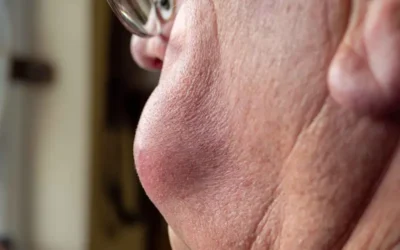Otosclerosis is regarded as one of the most common causes of progressive hearing loss in younger adults. This condition occurs when there is abnormal growth of small bone (called the stapes) inside the middle ear. The middle ear is the area behind the ear drum and it contains tiny bones that amplify sound waves. The condition is characterized by the abnormal formation of bone within the middle ear that stops these tiny bones from vibrating. This in turn causes hearing loss as the sound waves cannot reach the inner ear. In addition, the sense of balance may also be affected if the abnormal bone growth extends into the inner ear. The exact cause of otosclerosis is quite unclear, although genetic factors happen to play a crucial role. Other factors like viral infections (in particular, infection with the measles virus) also play a prominent role. On the other hand, some cases get worse more quickly during pregnancy, which indicates that changes in hormone levels play a significant role. Generally, hearing loss may affect both the ears, but it is more common for one ear to be severely affected than the other. If left untreated, otosclerosis will worsen gradually until late middle age when complete deafness occurs. Proper care and timely treatment can help people easily manage the symptoms and other complications associated with the condition. Ensuring that otologists and ENT specialists receive proper reimbursement for treatment procedures is important. Outsourcing medical billing and coding services help ENT specialists ensure accurate and timely claim filing and reimbursement.
Be Familiar with the Symptoms
One of the most common symptoms related to otosclerosis is hearing loss. Both conductive and sensory types of hearing loss may occur. However, in some rare cases both types of hearing loss may be present, (which is called mixed hearing loss). The loss may be gradual and may initially begin with an inability to hear low-pitched sounds or whispers. Common symptoms associated with the condition include –
- Dizziness or balance problems
- Tinnitus, or ringing, roaring, or hissing in your ears
- Particular difficulty hearing low, deep sounds and whispers
- Speaking quietly because your voice sounds loud to you
Treating Otosclerosis Symptoms
People who happen to experience trouble hearing sounds need to consult an otolaryngologist or audiologist. As part of the initial analysis, these specialists will closely inspect your ears and enquire about the symptoms. Audiologists will conduct simple hearing tests with tuning forks and audiometric tests to assess hearing and balance function. They will ask questions about your family history in detail to check whether any of your family members had suffered from hearing issues (as this disease can be inherited). The specialist may also study the movement of the ossicles using a machine called a “tympanometer” to perform a test called the stapedial reflex test, which is non-invasive, quick and painless. In some cases, a series of imaging tests like computerized tomography (CT) scan and X-rays will be taken at different angles and put together to make a more detailed image.
Otosclerosis can usually be treated successfully with either a hearing aid or surgery. Those who suffer from mild hearing loss may not need any treatment at first. Mild otosclerosis can be easily controlled with a hearing aid (that amplifies sound). Patients can either wear a “Bone-Conduction Hearing Aid” or a “Bone Anchored Hearing Device” which helps to better manage the associated hearing loss symptoms. An audiologist can discuss the various types of hearing aids available and make a recommendation based on the specific requirements of an individual. On the other hand, severe hearing loss problems can be effectively managed through surgery. In a procedure known as a stapedectomy, a surgeon inserts a prosthetic device into the middle ear to bypass the abnormal bone and permit sound waves to travel to the inner ear and restore hearing.
The diagnosis, screening tests and other treatment procedures performed by ENT specialists or audiologists must be carefully documented using the correct medical codes. Medical billing and coding services provided by reputable medical billing companies can help physicians use the correct codes for their medical billing purposes. The ICD-10 codes for Otosclerosis include –
H80 – Otosclerosis
H80.0 – Otosclerosis involving oval window, nonobliterative
- H80.00 – Otosclerosis involving oval window, nonobliterative, unspecified ear
- H80.01 – Otosclerosis involving oval window, nonobliterative, right ear
- H80.02 – Otosclerosis involving oval window, nonobliterative, left ear
- H80.03 – Otosclerosis involving oval window, nonobliterative, bilateral
H80.1 – Otosclerosis involving oval window, obliterative
- H80.10 – Otosclerosis involving oval window, obliterative, unspecified ear
- H80.11 – Otosclerosis involving oval window, obliterative, right ear
- H80.12 – Otosclerosis involving oval window, obliterative, left ear
- H80.13 – Otosclerosis involving oval window, obliterative, bilateral
H80.2 – Cochlear otosclerosis
- H80.20 – Cochlear otosclerosis, unspecified ear
- H80.21 – Cochlear otosclerosis, right ear
- H80.22 – Cochlear otosclerosis, left ear
- H80.23 – Cochlear otosclerosis, bilateral
H80.8 – Other otosclerosis
- H80.80 – Other otosclerosis, unspecified ear
- H80.81 – Other otosclerosis, right ear
- H80.82 – Other otosclerosis, left ear
- H80.83 – Other otosclerosis, bilateral
H80.9 – Unspecified otosclerosis
- H80.90 – Unspecified otosclerosis, unspecified ear
- H80.91 – Unspecified otosclerosis, right ear
- H80.92 – Unspecified otosclerosis, left ear
- H80.93 – Unspecified otosclerosis, bilateral
Reports suggest that otosclerosis affects more than 3 million Americans. Both men and women get otosclerosis, although women have a higher risk. Women aged between 15 and 30 years are most commonly affected by this condition. Symptoms usually are at their worst in their 30s.
Otolaryngology medical coding can be complex, as there are several codes associated with the condition. By outsourcing these tasks to a reliable and established medical billing and coding company (that provides the services of AAPC-certified coding specialists), healthcare practices can ensure correct and timely medical billing and claims submission.



